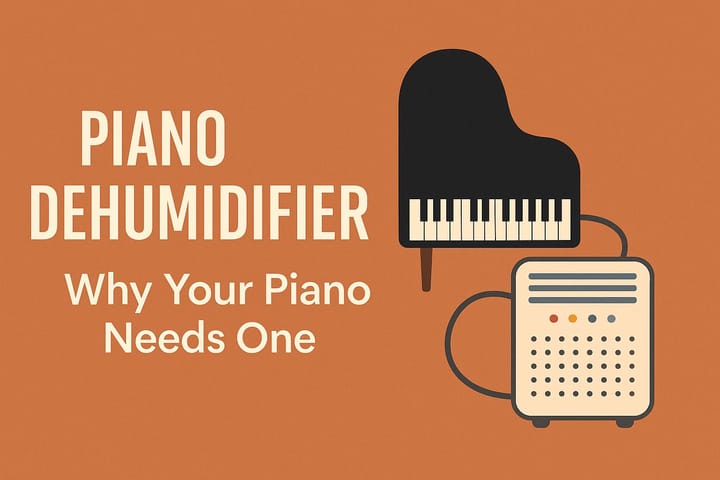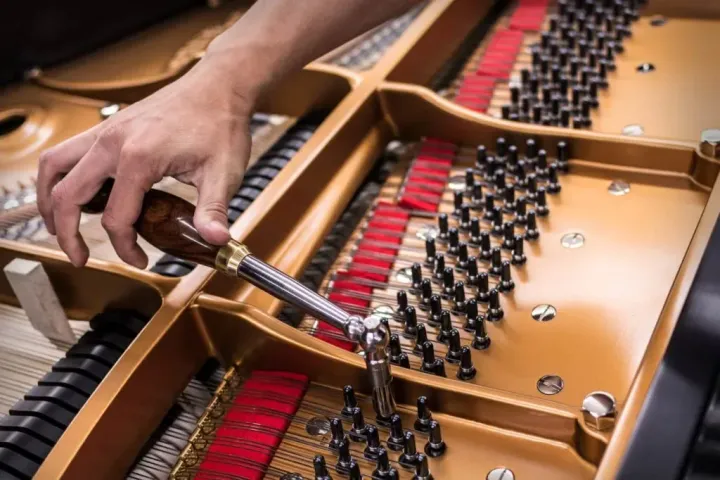Discover how temperature and humidity impact your piano's sound and longevity. Learn expert tips from a concert pianist to create the perfect climate for your instrument.
I remember a sweltering summer evening in Vienna, where I was set to perform a Chopin nocturne under the stars. As my fingers touched the keys for the opening notes, I was met with a sluggish, unresponsive action and a dull, lifeless tone. The culprit? The stifling heat and humidity had wreaked havoc on the piano, transforming my normally vibrant instrument into a lethargic shadow of its former self.
That experience, etched in my memory, taught me a crucial lesson: climate control isn't just a luxury for your piano; it's a necessity. Just as a Stradivarius violin requires meticulous care, so too does your piano crave a stable environment to sing its sweetest melodies. Whether you own a Steinway grand or a modest upright, understanding the impact of temperature and humidity is paramount for preserving your instrument's sound, playability, and longevity.
Wood, the heart and soul of a piano, is a hygroscopic material, meaning it absorbs and releases moisture in response to the surrounding atmosphere. Like a sponge, it swells when damp and shrinks when dry. This constant expansion and contraction can wreak havoc on the delicate balance of your piano's intricate mechanism.
In this guide, I'll share my expertise as a concert pianist and piano enthusiast, offering insights into the ideal climate conditions for your instrument and practical tips on how to achieve them. We'll delve into the detrimental effects of both high and low humidity, the subtle nuances of temperature fluctuations, and the most effective strategies for creating a harmonious environment for your beloved piano.
The Impact of Humidity on Your Piano
To truly appreciate the importance of humidity control, let's delve deeper into the science behind how moisture interacts with your piano's intricate construction. Wood, as I mentioned earlier, is hygroscopic. When the air is humid, the wood absorbs moisture and expands. Conversely, in dry air, it releases moisture and contracts. This seemingly innocent process can wreak havoc on your beloved instrument if left unchecked.
The Ideal Humidity Range: A Goldilocks Zone
The sweet spot for piano humidity lies between 40-50% relative humidity. This range creates an equilibrium where the wood is neither too swollen nor too shrunken, allowing the piano to perform at its peak. It's like finding the perfect balance for a soufflé – too much or too little moisture, and the result is disastrous.
High Humidity Problems: A Sticky Situation
When humidity levels creep above 50%, the wood in your piano begins to absorb excess moisture. This can lead to a cascade of problems, including:
- Sticking keys: The wooden parts of the action swell, causing keys to stick or feel sluggish. This can make playing frustrating and impede your musical expression.
- Sluggish action: The entire action mechanism can become sluggish and unresponsive, affecting the piano's touch and feel.
- Rust: Metal components, like tuning pins and strings, can start to rust, compromising their integrity and leading to tuning instability.
- Mold: In extreme cases, high humidity can promote the growth of mold and mildew, damaging the instrument's finish and posing health risks.
Low Humidity Problems: A Brittle Reality
On the other end of the spectrum, when humidity drops below 40%, the wood in your piano starts to dry out. This can lead to a different set of issues, equally detrimental to your instrument:
- Cracks in the soundboard: The soundboard, the heart of your piano's sound, can develop cracks as it shrinks, leading to a loss of resonance and tonal quality.
- Loose tuning pins: As the wooden pinblock contracts, the tuning pins can loosen, causing the piano to quickly fall out of tune.
- Brittle sound: The overall tone of the piano can become thin, harsh, and lacking in warmth as the soundboard loses its flexibility.
Understanding the delicate balance between high and low humidity is the first step towards creating an optimal environment for your piano. In the next section, we'll explore the impact of temperature on your instrument and how to maintain a consistent climate to protect its harmonious voice.
The Impact of Temperature on Your Piano
While humidity is the star player in the piano climate control orchestra, temperature plays a crucial supporting role. While less dramatic than the effects of humidity, temperature fluctuations can still wreak havoc on your piano's delicate balance, impacting its tuning stability and overall structural integrity.
Temperature Fluctuations: A Tuning Nightmare
Imagine your piano as a tightrope walker, precariously balancing on a thin wire of perfect pitch. Sudden temperature changes are like gusts of wind, threatening to knock it off balance. As the temperature rises, the metal frame of your piano expands, subtly increasing the tension on the strings and raising the pitch. Conversely, when the temperature drops, the frame contracts, potentially causing the pitch to fall.
While these individual fluctuations may seem minor, their cumulative effect over time can lead to significant tuning instability. Your piano may sound perfectly in tune one day and noticeably out of tune the next, making it difficult to play consistently and enjoyably.
Ideal Temperature Range: A Consistent Comfort Zone
To avoid this rollercoaster of pitch, aim to keep your piano in a room with a stable temperature, ideally between 68-72 degrees Fahrenheit (20-22 degrees Celsius). This range is comfortable for both humans and pianos, ensuring that the instrument's wooden components remain dimensionally stable and the tuning pins stay secure.
Extreme Heat
Just as we humans seek shade on a scorching summer day, your piano also needs protection from extreme heat. Avoid placing your piano in direct sunlight, as the intense heat can cause the wood to dry out and crack, particularly the soundboard. Additionally, proximity to heat sources like radiators, fireplaces, or heating vents can exacerbate these problems, leading to rapid fluctuations in temperature and humidity.
Extreme Cold
While less common, extremely cold temperatures can also pose a threat to your piano. If the temperature drops below freezing, the moisture inside the piano can freeze, expanding and potentially damaging the wooden components. Additionally, condensation can form on the metal parts, leading to rust and corrosion.
Maintaining a consistent temperature is key to preserving your piano's tuning stability and overall health. In the next section, we'll explore practical strategies for creating the ideal climate for your instrument, ensuring that it remains in tune and responsive throughout the seasons.
Creating the Perfect Climate for Your Piano
Now that we understand the delicate dance between your piano and its environment, let's explore how to create an oasis of stability for your instrument, ensuring its harmonious voice remains consistent throughout the year.
Humidity Control
Maintaining the ideal humidity range of 40-50% is crucial for your piano's well-being. To achieve this, you'll likely need both a humidifier and a dehumidifier, depending on the season and your local climate.
- Humidifier: In dry winter months or arid climates, a humidifier adds moisture to the air, preventing the wood in your piano from shrinking and cracking. Look for a model specifically designed for pianos, as these are often equipped with features like humidistats to automatically maintain the desired humidity level.
- Dehumidifier: In humid summer months or damp climates, a dehumidifier removes excess moisture from the air, preventing the wood from swelling and causing sticky keys or sluggish action. Choose a dehumidifier with a built-in humidistat to ensure you don't over-dry the air.
Hygrometer: Your Piano's Weatherman
Investing in a hygrometer, a device that measures humidity, is essential for monitoring the moisture levels in your piano's environment. Place the hygrometer near your piano, ideally on top of it or on a nearby wall. Regularly check the reading and adjust your humidifier or dehumidifier as needed to maintain the optimal humidity range.
Room Placement: Finding the Sweet Spot
Choosing the right location for your piano is crucial for its well-being. Avoid placing it near windows, vents, or exterior walls, as these areas experience greater temperature fluctuations and humidity swings. Instead, opt for an interior wall away from direct sunlight, drafts, and heat sources. If possible, position your piano on an inside wall near the center of the room to minimize exposure to environmental extremes.
Seasonal Adjustments: Adapting to the Changing Climate
As the seasons change, so too does the humidity in your home. Be prepared to adjust your climate control strategies throughout the year. In the winter, you may need to run your humidifier more frequently to combat dry air. In the summer, you might need to rely on your dehumidifier to keep moisture levels in check. Regularly check your hygrometer and adjust your humidifier or dehumidifier settings accordingly.
Additional Climate Control Tips
While humidifiers, dehumidifiers, and strategic room placement are the cornerstones of piano climate control, a few additional tips can further optimize the environment for your cherished instrument.
Dampp-Chaser Systems: A High-Tech Solution
For those seeking a more sophisticated and automated solution, consider investing in a Dampp-Chaser Piano Life Saver System. This ingenious device, often referred to as the "HVAC system for your piano," consists of a humidistat, a dehumidifier, and a humidifier that work in tandem to maintain a stable humidity level within the piano itself. It's like having a personal climate control expert living inside your instrument, ensuring optimal conditions year-round.
While Dampp-Chaser systems can be a significant investment, they offer several advantages, including:
- Precise humidity control: The system continuously monitors and adjusts humidity levels, eliminating the need for manual adjustments.
- Protection from extreme fluctuations: The system can quickly respond to sudden changes in the environment, protecting your piano from damage.
- Extended tuning stability: By maintaining optimal humidity, the system helps your piano stay in tune longer, reducing the need for frequent tunings.
If you're considering a Dampp-Chaser system, consult with a qualified piano technician to discuss the best options for your specific piano and environment.
HVAC Systems
Your home's heating, ventilation, and air conditioning (HVAC) system can also play a role in maintaining a stable climate for your piano. During the winter, when the air tends to be dry, use a humidifier in conjunction with your HVAC system to add moisture to the air. In the summer, set your air conditioner to a moderate temperature to prevent excessive humidity.
Piano Covers
While not a substitute for proper humidity control, a piano cover can provide an additional layer of protection against dust, sunlight, and accidental spills. Choose a breathable fabric cover that allows air to circulate to prevent moisture buildup.
Professional Advice: Seek Expert Guidance
If you're unsure about the best climate control strategies for your specific piano and location, don't hesitate to consult with a qualified piano technician. They can assess your home's environment, recommend appropriate equipment, and provide personalized advice to ensure your instrument thrives.
By implementing these additional tips, you'll create a haven of stability for your piano, protecting it from the elements and ensuring that it always sings with a clear, resonant voice. Remember, a well-cared-for piano is a joy to play and a cherished companion for years to come.
As a concert pianist, I've witnessed firsthand the transformative power of climate control on a piano's sound and longevity. From the sweltering stages of Vienna to the dry concert halls of New York City, I've learned that a stable environment is essential for my instrument to sing its best.
Whether you're a professional musician or a passionate amateur, your piano deserves the same level of care and attention. By understanding the impact of humidity and temperature, and implementing the strategies outlined in this guide, you can create a harmonious haven for your instrument, ensuring that it remains in tune, responsive, and vibrant for years to come.
Remember, your piano is more than just a collection of wood and strings; it's a vessel for your musical expression, a source of joy, and a cherished companion. Treat it with the care it deserves, and it will reward you with a lifetime of beautiful music.





Comments ()